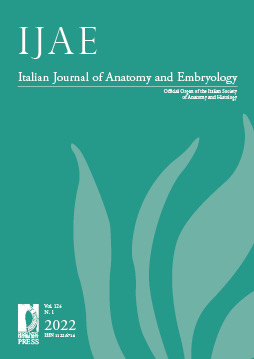Published 2022-09-21
Keywords
- sarcoglycans,
- thyrocytes,
- integrin,
- immunofluorescence,
- thyroid
How to Cite
Abstract
The sarcoglycan sub-complex is a protein system which plays a key role in sarcolemma stabilization during muscle activity consisting of six glycosylated transmembrane proteins. Integrins play a key role in the process of cell adhesion, linking the extracellular matrix to the actin cytoskeleton. Here we have analysed the receptor for thyroid hormone, identified on αvβ3-integrin that has an important role in the activation of non-genomic actions of the hormone. Many non-genomic actions of the thyroid hormone appear to contribute to basal levels of activity of a variety of proteins, including ion pumps, intracellular protein trafficking and protein turnover. The purpose of our research was to study the presence and behaviour of sarcoglycans and integrins on the thyroid gland, in both normal and pathological conditions, for the first time. Our results show a normal fluorescence pattern in patients without pathology, and a reduced fluorescence pattern in patients with thyroid disease. Moreover, colocalization in healthy patients was found in double localization reactions, whereas in patients with Hashimoto’s thyroiditis sarcoglycans did not colocalize with tested integrin. These data could confirm the hypothesis of a close association between sarcoglycans and integrins, which, in pathological condition, are not found contemporarily hypothesizing that each single protein system could have a role in maintaining cell vitality.


